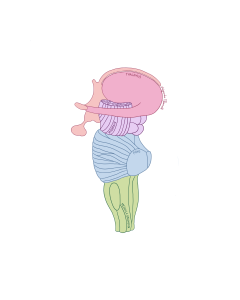41
What is the brainstem?
Moving just superior to the spinal cord is a vital structure at the base of the brain that serves as a communication hub between the brain and the rest of the body, playing a crucial role in regulating essential life functions such as breathing, heart rate, and consciousness. This structure, or rather a collection of three structures stacked upon one another, is known as the brainstem. It can be divided as depicted in figure 94. The brainstem sits between the spinal cord and the inferior portion of the brain and consists of 3 main structures:

Figure 95 The brainstem and its 3 components situated below the thalamus
- The medulla oblongata (simply referred to as the medulla) is the life support operations centere of the body. It is an automatic regulator, responsible for maintaining several homeostatic functions including heart rate, vasodilation (widening of the blood vessels), vasoconstriction (narrowing of the blood vessels), breathing rhythm, as well as reflexes like vomiting, swallowing, coughing, sneezing, and hiccupping. Imagine going for a hike in the mountains. The medulla is the non-negotiable, keep-it-alive system working in the background so your body can function on the trails without you having to think about it.
- The pons serves as a communication centre of the brain, transmitting signals from the brain down to the spinal cord, keeping things running smoothly across the CNS. The pons is also responsible for regulating rhythms like breathing and the body’s sleep-wake cycle through secreting several neurotransmitters – making sure hikers start the day energized and wind down as the sun sets, keeping everyone on a steady, natural schedule.
- The most superior section of the brain stem, the midbrain, can be divided into two sections: the tectum (posterior) and the tegmentum (anterior).
- The tectum contains four rounded nuclei, divided into two superior colliculi and two inferior colliculi. The superior colliculi functions as a reflex centre for visual stimuli, while the inferior colliculi handle auditory processing. Together, they help the brain respond to changes in the environment, whether they are visual or auditory. While hiking out on a sunny day, you may grow accustomed to the serene sounds of nature around you, but the sound of a branch breaking might signal to you the presence of a predator. This is detected and processed by the inferior colliculi. The darkening of the sky pointing to a possible rainstorm is processed by the superior colliculi.
-
- The tegmentum is more involved with motivation and alertness. It houses the substantia nigra, which produces dopamine (critical for movement and motivation), the red nuclei involved in motor coordination, and the reticular formation, a network that plays a key role in maintaining alertness and consciousness. This part of the midbrain ensures you remain active, responsive, and engaged with your goals of hiking that mountain. Damage to the tegmentum may lead to a lack of motivation, wanting to stay indoors, or leave you unaware of your surroundings.

